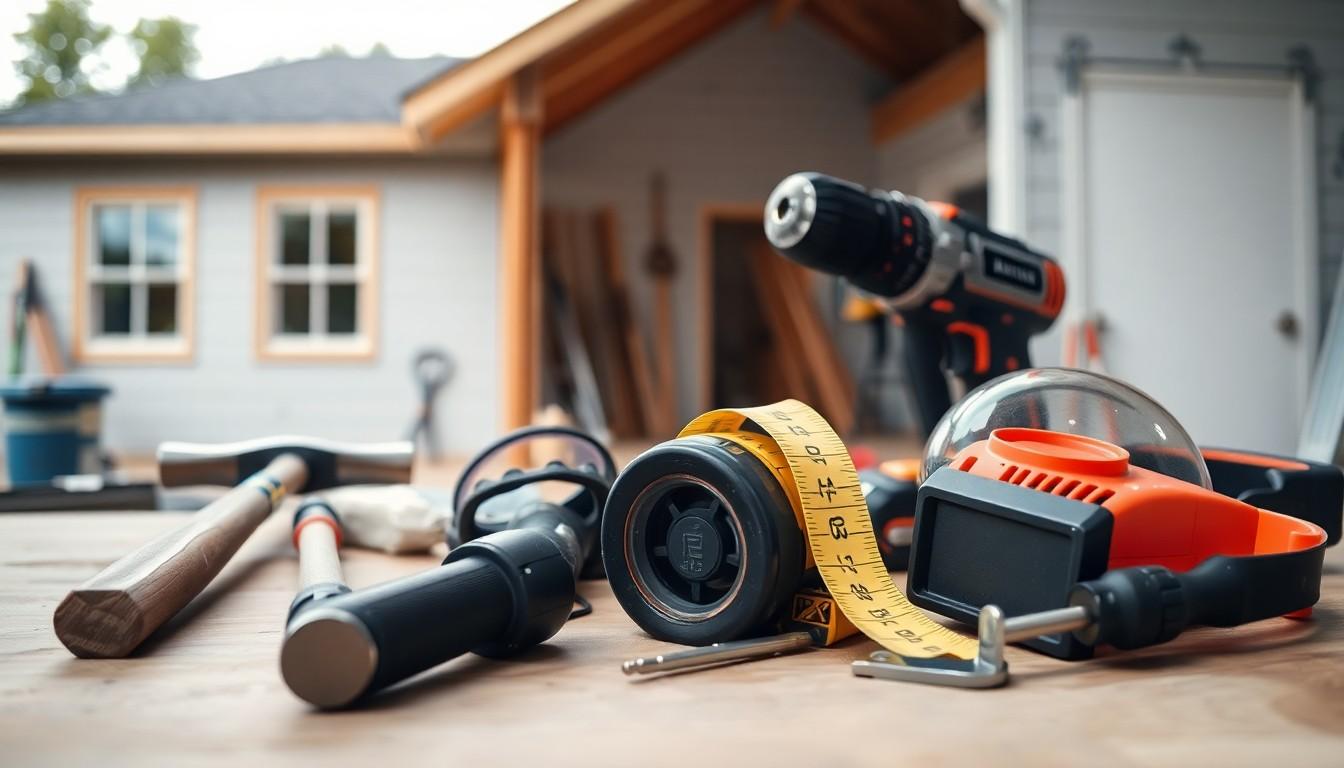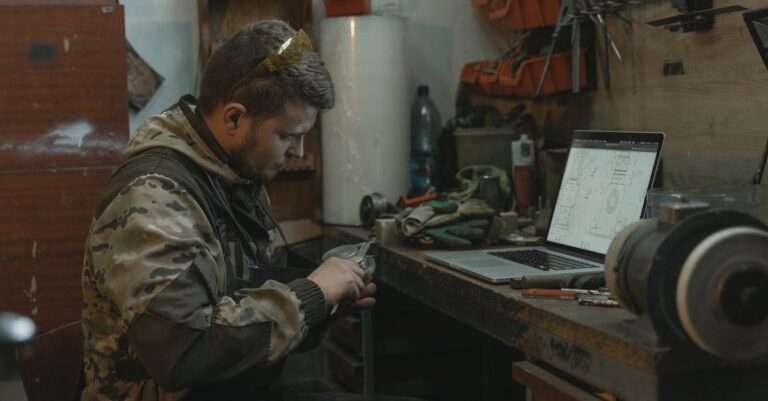Building a home might sound like a daunting task, but what if it could be more fun than a Saturday night binge-watching DIY shows? With a little creativity and the right tools, anyone can transform from couch potato to home-building hero. Imagine the satisfaction of saying, “I built that!” while your friends stare in awe—or envy.
Table of Contents
ToggleOverview of DIY Home Building
DIY home building transforms the idea of constructing a home into a fulfilling journey. Creating a personal space allows for customization and expression. For many, the first step involves researching plans and tools, ensuring the project aligns with personal skill levels and budget constraints.
Effective planning lays the foundation for a successful build. Estimating costs and timelines prevents unforeseen challenges. Choosing materials carefully contributes to durability and aesthetics. Many builders opt for sustainable or reclaimed materials, enhancing eco-friendliness in their designs.
Tools play a vital role in the process. Hand tools, such as hammers and saws, join power tools like drills and nail guns. Using the right tools increases efficiency and ensures quality results. Safety equipment, including gloves, goggles, and hard hats, should never be overlooked.
Skill-building courses and workshops provide valuable knowledge. Many community colleges and local organizations offer classes in carpentry, plumbing, or electrical work. Acquiring these skills boosts confidence and reduces reliance on outside contractors.
Networking with experienced builders enhances the learning process. Online forums and social media groups connect aspiring builders with mentors. Sharing experiences and tips fosters a supportive community, encouraging beginners to take the plunge.
Time investment often determines the scale of projects. Smaller tasks can be completed over weekends, while larger builds may require several months. Breaking down projects into manageable steps simplifies the process and maintains motivation.
Ultimately, the experience of DIY home building cultivates pride and accomplishment. Fulfilling personal visions while creating functional living spaces strengthens the bond between builders and their homes. Building together creates lasting memories for families and friends, adding to the overall joy of homeownership.
Essential Tools and Materials

Effective DIY home building relies on the right tools and materials. Utilizing these essentials streamlines the process and enhances results.
Must-Have Tools for DIY Projects
Hand tools like hammers, screwdrivers, and saws are crucial for basic tasks. Power tools, including drills and circular saws, significantly increase efficiency. A level ensures precise measurements, while a tape measure aids in accuracy. Safety gear, such as goggles and gloves, protects against potential hazards. Additionally, a workbench provides a stable surface for assembly. Investing in quality tools ensures longevity and effectiveness in projects.
Choosing the Right Materials
Selecting materials impacts both construction quality and aesthetics. Consider structural integrity when choosing lumber; options include softwoods for framing and hardwoods for visible components. Sustainable materials, such as bamboo and reclaimed wood, offer eco-friendly alternatives. Readily available options like plywood and OSB work well for various applications. Vinyl or fiber-cement siding provides low-maintenance exteriors. Prioritize materials that meet both budgetary and environmental goals.
Planning Your DIY Home Build
Effective planning serves as the foundation for a successful DIY home build. Focusing on critical components ensures a smooth process and a rewarding outcome.
Creating a Comprehensive Blueprint
Creating a detailed blueprint sets the stage for a successful build. Drafting plans clarifies the layout, room dimensions, and overall flow of the home. Incorporating features like windows, doors, and plumbing helps visualize the project. Utilizing software programs or hiring a professional can provide precision and enhance creativity. Specification of materials and finishes early on simplifies the selection process later. Collaborating with builders or designers offers insight into structural requirements and potential adjustments.
Budgeting for Your Project
Budgeting effectively prevents financial strain during the DIY home building process. Estimating costs involves accounting for materials, labor, permits, and unexpected expenses. Prioritizing your budget ensures that essential elements receive adequate funding. Utilizing spreadsheets can help track expenses and maintain clarity. Setting aside a contingency fund, usually 10-20% of the total budget, prepares for unforeseen challenges. Researching materials and sourcing local suppliers often leads to savings. Balancing quality with cost enhances long-term sustainability and satisfaction in the final product.
Common Challenges in DIY Home Building
DIY home building presents unique challenges that can impact the overall experience. Effectively managing time and handling unexpected issues are two critical aspects that builders must navigate.
Time Management
Time management proves crucial during the DIY home building process. Setting a realistic timeline ensures that tasks align with personal schedules. Smaller projects, like painting a room or installing flooring, can often be completed over weekends. Larger tasks, such as framing or plumbing, demand more comprehensive planning. Break down projects into manageable parts, allowing for realistic milestones. Consistently tracking progress helps maintain motivation and focus. Allocating buffer time for delays and unexpected complications prevents frustration down the line.
Dealing with Unexpected Issues
Dealing with unexpected issues requires adaptability and resourcefulness. In the course of building, problems such as material shortages or weather-related delays may arise. Anticipating potential setbacks and creating contingency plans helps mitigate stress. A proactive approach to troubleshooting promotes quick resolution of obstacles. Utilizing community resources like forums or local workshops can provide valuable assistance and advice. Flexibility is key; adjusting timelines or project scopes can lead to successful outcomes. Builders often find that embracing challenges strengthens their skills and confidence.
Tips for Successful DIY Home Building
Successful DIY home building requires careful attention to detail and adherence to best practices. Prioritizing safety and utilizing effective techniques streamline the entire process.
Best Practices for Safety
Safety serves as the primary focus in any home building project. Wearing personal protective equipment like goggles, gloves, and dust masks prevents injuries and hazards. Securing the work area ensures that tools and materials don’t pose risks. Following manufacturer instructions for tools and materials also enhances safety. Ensuring proper ventilation while working with chemicals protects against harmful fumes. Additionally, keeping a first aid kit nearby prepares builders for any minor accidents that may occur.
Effective Techniques and Hacks
Utilizing effective techniques enhances productivity while working on home projects. Starting with a detailed plan aids in organizing tasks, preventing confusion and wasted time. Labeling tools and materials saves time searching for items during work. Using a chalk line for straight cuts ensures precision when framing walls. Applying a level guarantees even surfaces, which simplifies subsequent tasks. Gathering all necessary tools before starting minimizes interruptions. Moreover, employing a time tracking app helps monitor progress, fostering accountability and motivation.
DIY home building offers a unique opportunity for personal expression and creativity. With careful planning and the right tools anyone can transform their vision into reality. Embracing the process not only leads to a sense of accomplishment but also strengthens the connection between individuals and their homes.
By prioritizing safety and attention to detail builders can navigate challenges effectively. The journey may require time and patience but the rewards are immeasurable. Ultimately the experience of creating a home fosters lasting memories and a deep sense of pride.



